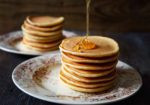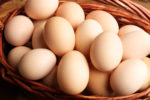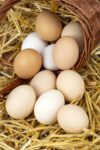
How to Tell if Eggs are Fresh
In the U.S., the eggs we buy in stores today are kept refrigerated and have dates stamped on the cartons. So it’s easy to know if they’re still fresh.
But in the 1800s, electricity was not yet available in homes. Refrigerators were insulated boxes that held a block of ice to keep food cold. Since there wasn’t much room inside, eggs were rarely kept there.
As long as eggs were not washed, they could be kept at room temperature; but not indefinitely. And there was always the chance that an egg might be left behind in a nest and gathered days later with fresher eggs.
Therefore, people had to make sure their eggs were still fresh before cooking or adding them to a recipe.
INFORMATION BELOW COMPILED FROM 1800s COOKBOOKS:
HOW TO CHOOSE EGGS IN THE MARKET
One way of judging the quality of eggs is observing the surface of the shell. When eggs are freshly laid, the shell is covered with a substance called bloom, that gives it a feeling much like that of a thin lime coating deposited in a pan after water boils.
This coating disappears gradually as the egg is exposed to the air, but as long as it remains, the egg may be considered fresh and germ-proof. While this way of determining freshness is probably the quickest, it is possible that the quality of some eggs from which the bloom has recently disappeared has not been injured.
A fresh egg has a rough shell. And if eggs of the best quality are desired, medium-sized ones that are uniform in size and color should be selected. With regard to shape, they should have a comparatively long oval shell, one end which is blunt and the other, a sharp curve.
Clean eggs are the most desirable, but it is not advisable to wash eggs that are to be kept for even a short time, as washing them removes the natural coating that helps to prevent the entrance of bacteria. However, as it is necessary that the shells be perfectly clean before they are broken or before the eggs are cooked, the eggs may be washed or wiped with a damp cloth immediately before such processes.
JUDGING THE QUALITY OF EGGS IN THE HOME
Eggs kept in a clean cool space do not deteriorate under a month. Even after that, thus well kept, they answer for cake making, puddings and so on. But they have an ungodly affinity for taints of almost every kind. Hence keep them away from such things as onions, salt fish, things in brine generally, or any strong ill odors.
After eggs have been received in the home, there are several simple tests for determining their freshness.
SHAKING
When the water inside the shell evaporates, the yolk and white shrink so much that they can be felt moving from side to side when the egg is shaken. The staler the egg, the more pronounced does the movement become. This method should be applied only immediately before the egg is to be used, as the thin membrane between the yolk and the white and the spiral cords that hold up the yolk are liable to be disturbed by the shaking. If they are broken, the yolk will settle and finally adhere to the shell in case the egg is stored for any length of time after that.
If nothing has been done to preserve eggs, another test consists in placing the eggs in a glass containing water. A perfectly fresh egg will sink when it is put into the water, but if the egg is three weeks old, the broad end will rise slightly from the bottom of the glass. An egg that is three months old will sink into water until only a slight portion of the shell remains exposed. If the egg is older or stale, it will rise in the water until nearly half of it is exposed.
CANDLING
The test known as candling, which is usually applied to eggs before they are put on the market, can also be practiced in the home. This method consists in placing a piece of cardboard containing a hole a little smaller than an egg between the eye and a light, and holding the egg in front of the light.
The rays of light passing through the egg show the condition of the egg, the size of its air space, and the growth of mold or the spoiling of the egg by any ordinary means. When an egg is fresh, the yolk will be barely distinguishable from the white except as a slightly darker area in the center of the egg, and the entire egg will appear clear and bright and free from spots.
In an egg that is a little older, candling will reveal a slightly darker yolk, a cloudy white, and a larger air space. In a watery egg, or one that is beginning to spoil, various dark spots and blotches usually develop. When an egg is rotten, the contents of the shell will look dark in candling and the yolk will appear to be mixed with the white.
BREAKING
You can also determine the condition of an egg by breaking it into a saucer and examining it carefully. If the egg is newly laid, no odor will be detected and the white will be clear, elastic, and rather thick; and where it joins the yolk it will be almost solid.
The yolk of such an egg will have an even yellow color, without lighter or darker spots and will stand up well from the surface of the white. Sometimes a small spot of blood may be detected on the yolk of a perfectly fresh egg, but while this is not pleasant to look at, it does not affect the quality of the egg.
When an egg that is not real fresh is broken into a saucer, the yolk will lie flat. In an egg that is quite stale, the membrane surrounding the yolk is easily destroyed, so that even when such an egg is broken carefully, the yolk and the white are likely to run together.
=================================================
How do You Like to Cook Eggs? Please Leave a Comment Below.
=================================================
 VINTAGE COOKING from the 1800s ~ EGGS
VINTAGE COOKING from the 1800s ~ EGGS
by Angela A Johnson
How did people cook and store eggs without electricity?
This book tells how to determine freshness, how to cook, and how to preserve eggs.
Recipes include Fried, Poached, Baked, and Boiled Eggs, Omelets, Soufflés, Egg Balls, Custards, Puddings, Dressing, Sauces, Creams, Drinks, and more…..
Available as a Regular print or Large print book on Amazon.
Regular Print Edition – https://www.amazon.com/dp/1072843749
Large Print Edition – https://www.amazon.com/dp/1691426873/
Ebook version available from Online Retailers (click here): Amazon, Kobo, Apple, Barnes&Noble, Scribd, 24 Symbols, Playster, Angues & Robertson, Mondadori Store, and more.
=================================================





2 thoughts on “How to Tell if Eggs are Fresh”
Great information for all of us who have never really had a farm fresh egg.
I buy pasture raised eggs from the grocery store, but it’s not the same as farm-fresh. My cousin raised chickens and ducks and she gave me eggs from each when I visited. I thoroughly enjoyed them. She didn’t wash her eggs right away, either, just like the advice given in old cookbooks.